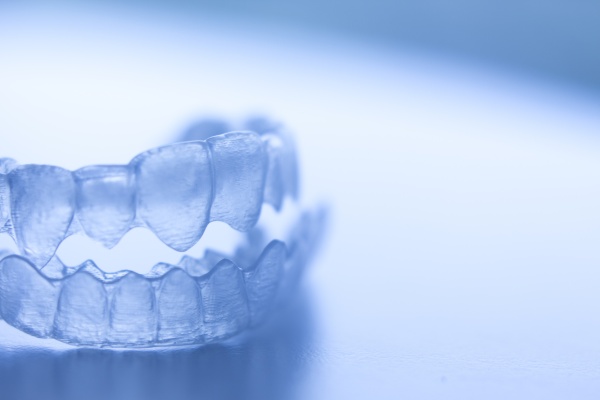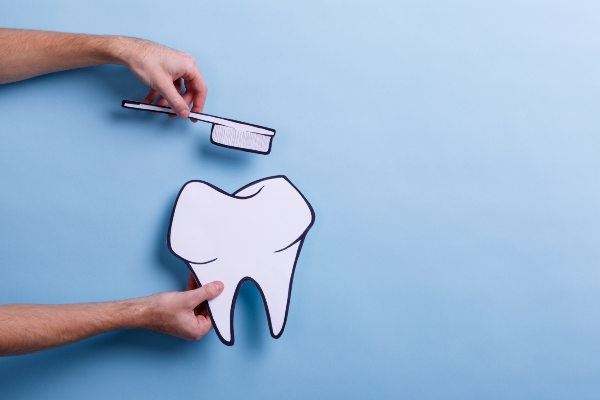How Invisalign® Works

Invisalign® is a relatively new system of teeth straightening that has gained popularity in recent years. In the past, the only option for those with crooked teeth, overbites and underbites was using traditional braces to straighten their smiles. Though Invisalign® has been proven to provide stunning results, some are still unfamiliar with the process of this clear aligner system.
How does the Invisalign® system work?
Although the Invisalign® system is fairly straightforward and almost always provides optimal results, it is a good idea to get as much information as possible before starting on a teeth-straightening regimen.
Invisalign® vs. traditional braces
Where braces use a combination of brackets, wires and ligatures, Invisalign® consists of a series of clear aligners. The aligners created by Invisalign® are clear, custom plastic trays that are designed to fit snugly over the teeth. Invisalign® dentists create digital 3D models of the teeth at the initial consultation appointment. These models are then used to create several aligners, which will place pressure on certain areas in the mouth at specific points. Each clear aligner is to be worn for a period of either one or two weeks. The treatment lasts anywhere from a few months to over a year, depending on each individual case.
Chunky, uncomfortable metal brackets and wires are a thing of the past. Invisalign® offers a teeth-straightening solution that is more comfortable, healthy and convenient in daily life.
The technology behind Invisalign®
After a consultation appointment in which the dentist will help design a customized treatment plan, the clear aligners are created in the dental laboratory. The teeth are scanned from all directions, creating a 3D digital impression of the entire smile, top and bottom. The aligners then use these models of the teeth to move each tooth to a straightened position.
Advantages of Invisalign®
Invisalign® clear aligners have many benefits over braces. Besides the fact that they are virtually invisible, both in person and in photos, clear aligners are also more comfortable than traditional braces. Braces have brackets and wires that pull on the teeth and add unnecessary sensitivity at every tightening appointment.
Another benefit to Invisalign® is the fact that these clear aligners are removable. The dietary limitations that come with traditional braces do not apply with Invisalign®. Dentists only ask that patients remove their clear aligners when eating, drinking hot beverages and brushing teeth.
Due to the fact that Invisalign® aligners are removable and not fixed to the teeth like traditional braces, the teeth are healthier for it. When brackets from conventional dentures are fixed to the teeth, that surface area on the teeth is not cleaned for months. Small white spots, signs of early tooth decay, can form underneath brackets and make for an unsightly reveal once the braces are removed. With Invisalign®, patients can thoroughly clean their teeth, making for a healthier, brighter smile once treatment is completed.
Invisalign® is the clear choice
Ready for a smile that stuns? Teeth straightening is just a phone call away. Give our office a call to schedule your initial consultation and get on your way to a better, brighter smile.
Request an appointment here: https://www.palmbeachdentistry.com or call Palm Beach Dentistry at (561) 225-2057 for an appointment in our Delray Beach office.
Check out what others are saying about our services on Yelp: Read our Yelp reviews.
Recent Posts
Routine dental care is one of the most important factors contributing to good dental health. While going to the dentist twice a year is the standard rule of thumb, the frequency of the visits ultimately depends on the patient's needs and the recommendation of the dentist. Learn how often routine care should be scheduled and…
Prioritizing routine dental care is necessary for good health. Unfortunately, some people can find it difficult to care properly for their teeth by brushing, flossing, and seeing a dentist on a regular basis. Patients who disregard dental hygiene and professional care need immediate action to prevent dangerous outcomes.In addition to an unsightly smile, failing to…
Many people may believe that they do not have time for routine dental care, which consists of daily brushing and flossing as well as periodic cleaning by a dentist. Admittedly, these tasks do take some time but should be a priority even in a busy schedule. People who do not take time for brushing, flossing,…
Professional dental cleanings are integral for keeping your mouth healthy. They remove plaque and tartar (hardened plaque) that regular brushing and flossing cannot, leaving your teeth and gums refreshed. Maintaining healthy habits that keep your smile bright and strong is essential to make the most of a dental cleaning. Caring for your teeth properly after…


